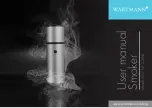
These instructions are written in accordance with the
installation guidelines of NFPA No. 72, National Fire
Alarm Code, and CAN/ULC-S524, The Installation of
Fire Alarm Systems.
CAUTION
Detector Storage
DO NOT install the detector until all construction
is completed.
DO NOT store this detection device where it can
be contaminated by dirt, dust, or humidity.
DETECTOR PLACEMENT
Although no specific spacings are set for the detectors
used for the 0 to 300 ft/min clean air velocity applica-
tion, use 30 foot center spacing (900 sq ft) from NFPA
72, National Fire Alarm Code, Chapter 5, if practical,
as a guide or starting point for a detector installation
layout. This spacing, however, is based on ideal
conditions—smooth ceiling, no air movement, and no
physical obstructions. In some applications, therefore,
considerably less area is protected adequately by each
smoke detector. This is why it is mandatory to closely
follow the installation drawings. In all installations
(except in special circumstances, such as in computer
room underfloors where the velocity may be up to 1200
ft/min) place the detector on the ceiling, a minimum of
12 inches from a side wall, or on a wall, 6 inches from
the ceiling.
If you have questions regarding detector placement,
follow the drawings provided or approved by Siemens
Building Technologies, Inc. or by its authorized
distributors. This is extremely important! The detector
placements shown on these drawings were chosen
after a careful evaluation of the area that is protected.
Factors such as air currents, temperature, humidity,
pressure, and the nature of the fire load were carefully
considered. Especially noted were the room or area
configuration and the type of ceiling (sloped or flat,
smooth or beamed). Siemens Building Technologies,
Inc.'s extensive experience in the design of the system
assures the best detector placement by following these
drawings. Sound engineering judgment by qualified
personnel must be followed.
Smoke and Fire Detector Models
ILI-1, ILI-1H, ILI-1A, and ILI-1AH
Fire Safety
Installation Instructions
TO AVOID NUISANCE ALARMS WITH THESE
DETECTORS:
DO NOT LOCATE
the detectors next to an oil burner,
kitchen, or garage where exhaust fumes can trigger
an alarm. Other causes of nuisance alarms are dust
accumulation, heavy concentrations of steam, heavy
pipe or cigar smoke, aerosol sprays, high air velocity,
or in an area of prolonged high relative humidity where
condensation occurs.
NOTE:
Except in the case of the ILI-1A and ILI-1AH
where the detector can be used for high air
velocity applications of up to 1200 feet per
minute.
AIR CURRENTS
Before a detector can sense a fire, the products of
combustion or smoke must travel from the fire to the
detector. Since their travel is influenced by air currents,
consider the movement of air in the design of the
system. While combustion products tend to rise, drafts
from hallways, air diffusers, fans, etc., may help or
hinder the travel of combustion products to the
detector. When positioning a detector at a particular
location, consider the position of windows and doors,
both open and closed, and air movement. Never install
a detector in the air stream of a room air supply diffuser.
It is better to position a detector closer to an air return.
The distance that products of combustion or smoke travel
from a fire to the detector is not usually the shortest linear
route. Combustion products or smoke usually rise to
the ceiling, then spread out. With an average ceiling
height (8 to 10 feet), this is not an abnormal factor.
However, with high ceilings such as in churches, ware-
houses, auditoriums, etc., consider the height.
SPECIAL CEILING CONSTRUCTION FACTORS
Ceiling obstructions can change the natural movement
of air and combustion products. Depending on the
direction of smoke travel, joists and beams can slow
the movement of heated air and smoke, while pockets
between them can contain a reduced level of
smoke.Take obstructions created by girders, joists,
beams, air conditioning ducts, or architectural design
into consideration when determining area protection.
P/N 315-095387-5
Siemens Building Technologies, Inc.
8 Fernwood Road
Florham Park, New Jersey 07932
Siemens Building Technologies, Ltd.
2 Kenview Boulevard
Brampton, Ontario L6T 5E4 CN






















